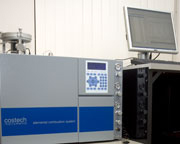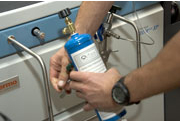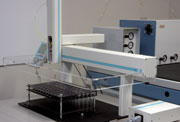Solid Samples
 EA and TC/EA
EA and TC/EA
We can analyze a variety of matrices (soil, plant, vertebrate, invertebrate, organic and inorganic) for C, N, H, O, S stable isotopic composition or quantitative elemental composition through dedicated combustion and pyrolysis elemental analyzers. Samples must be dried and ground to a consistent particle size.
 The amount of sample required is dependent on the sample’s elemental composition, so please contact the laboratory manager (bharlow@wsu.edu) for the appropriate mass before weighing your own samples. Samples must be weighed in tin capsules for 13C, 15N, or 34S analysis, and silver capsules for 18O & 2H analysis. Filled and folded capsules can be shipped in secured 96 position cell plates.
The amount of sample required is dependent on the sample’s elemental composition, so please contact the laboratory manager (bharlow@wsu.edu) for the appropriate mass before weighing your own samples. Samples must be weighed in tin capsules for 13C, 15N, or 34S analysis, and silver capsules for 18O & 2H analysis. Filled and folded capsules can be shipped in secured 96 position cell plates.
Dried and ground samples can be submitted bulk in vials for our staff to weigh into the appropriate capsule. With this option, we analyze test samples for elemental composition and determine the appropriate amount. See additional services or contact the lab manager for more information.
Special note on foreign soil analysis: Our laboratory is approved to receive and process foreign soils regulated by the USDA and APHIS PPQ. Shipments of these items require special handling and treatment; please contact the laboratory manager for details.
It is the responsibility of the sample submitter to determine sample requirements, concerns or additional preparations required for their study. Please contact the laboratory manager before submitting samples (bharlow@wsu.edu).
Gas Samples
Dual Inlet
 Gas samples are analyzed via our dual inlet system in flame sealed glass tubes via tube breaker, or lecture bottles or similar that terminate with 1/4” fittings.
Gas samples are analyzed via our dual inlet system in flame sealed glass tubes via tube breaker, or lecture bottles or similar that terminate with 1/4” fittings.
Gas Bench II
Samples are analyzed in 12-mL vials with septa caps. In some cases, use of our pre-evacuated vials may be possible. Contact the lab manager for details.
We use NIST, IAEA, and lab acquired carbonates digested with 100% H2PO4 for 13C and 18O normalization. QC carbonate samples, our CO2 monitoring gas and a CO2 flush fill tank provide monitoring of final calculated delta values.
Water Samples
Gas Bench II
Samples are analyzed in 12-mL vials with septa caps. If desired, our staff can pipet water samples to vials for a minimal charge per sample. In some cases, use of our pre-evacuated vials may be possible. Contact the lab manager for details.
TC/EA
We use a GC PAL autosampler and modified reactor for liquid injections on the TC/EA. Samples should be in 2 mL screw top vials (12×32 mm) with 8mm diameter septa caps. If desired, WSU laboratory staff can pipet samples into vials for a minimal charge. In the event of small samples, vial inserts can be used.
Compound Specific
 GC-C
GC-C
We utilize an existing GC-MS in the WSU LBB2 unit for assistance with compound identification, retention times, and methods development. Samples should be in 2 mL screw top vials (12×32 mm) with 8mm diameter septa caps. In the event of small samples, vial inserts can be used. All derivation of samples is to be performed by the client. Derivation with
methlyboronic acid (MBA) or trimethylsilyl (TMS) is recommended. Due to the specificity and time requirement for these analyses, availability is typically limited to internal clients only. Contact the lab manager for details.
Data Normalization and Quality Control
Instrument stability checks and necessary calibrations are performed prior to all analyses. Instruments are tuned to exceed factory specifications for linearity, or bias associated with amplitude. In addition, samples, reference material, and monitoring gasses are prepared to yield signals of the same amplitude.
Final isotopic data is calculated using multi-point normalization from at least two internal running standards or certified reference material with a wide span of delta values. All running standards are calibrated biannual to 3 or more NIST and IAEA certified reference material. Standards used are selected to be of a similar matrix and elemental ratio as your samples. For quality control, we include at least two “blind” QC samples of similar composition in all sample sequences. Summaries of these QC standards from multiple analyses, multiple days, and instruments are available upon request. Our laboratory also participates in periodic ring tests with multiple laboratories.
For a 49 sample EA sequence for CN analysis, this amounts to 12 calibrated references distributed throughout the run.
